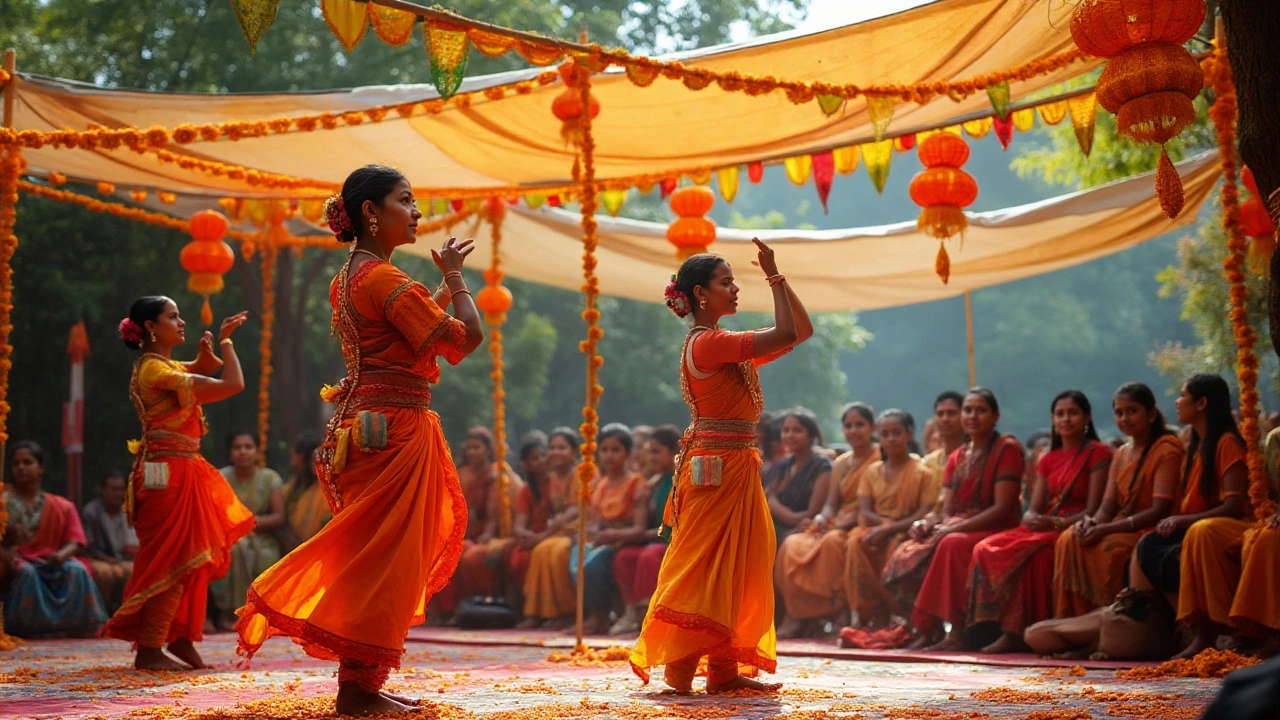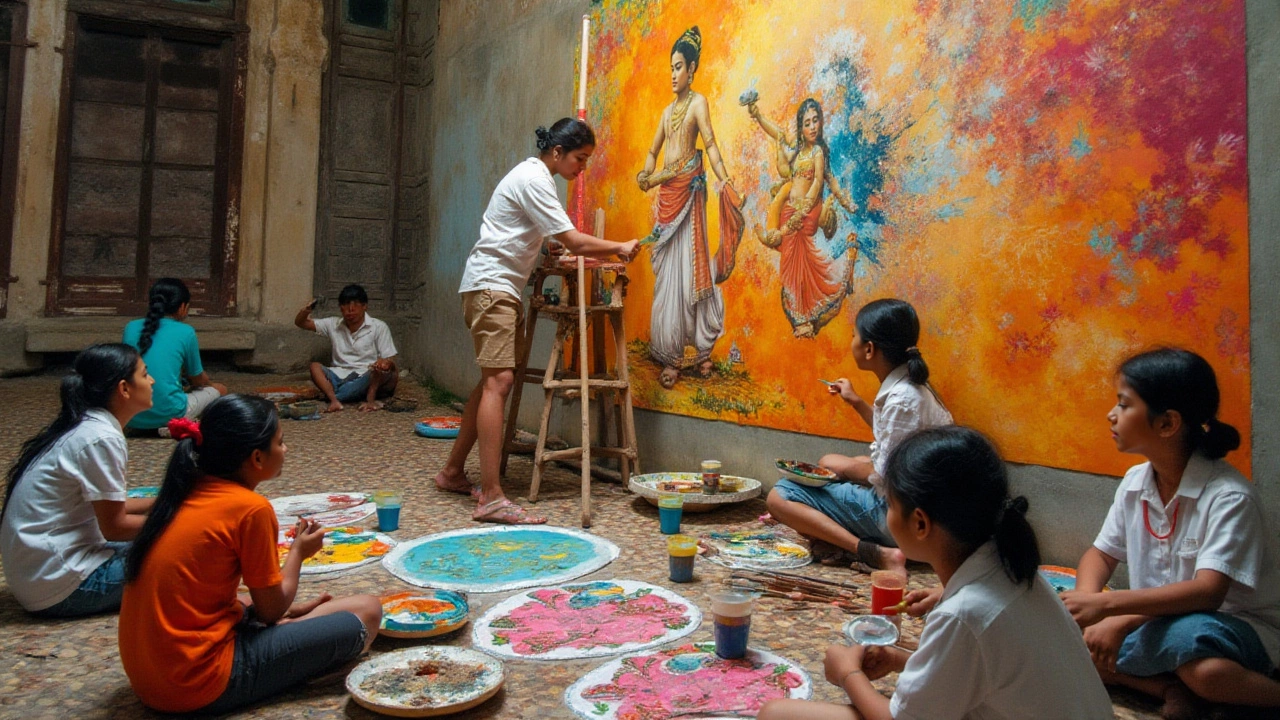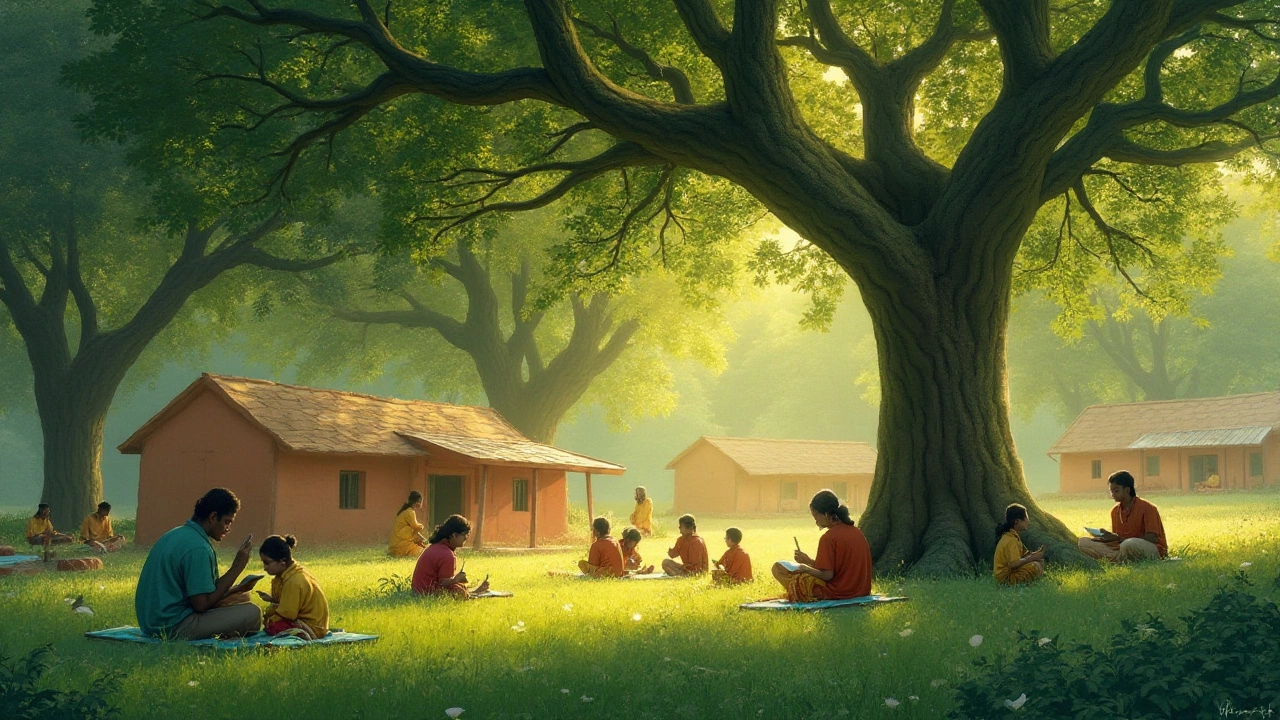Nestled in the serene landscapes of West Bengal, Shantiniketan emerges as a beacon of cultural heritage and educational reform in India. Established by the revered poet and philosopher Rabindranath Tagore, this quaint town exudes a unique charm that marries tradition with modernity. The site is not merely a reflection of Tagore's vision but also stands as a testament to his innovative approaches in education and art. It's no wonder that its candidacy as a UNESCO World Heritage Site has been a topic of interest globally.
Shantiniketan's influence stretches far beyond its geographical boundaries. As a center for cultural and artistic revolution, it offers a glimpse into the diverse cultural tapestry of India. Visitors to Shantiniketan can immerse themselves in its rich history, explore its arts and crafts, and experience the harmonious blend of natural beauty and human creativity. With its picturesque gardens and distinctive educational model, Shantiniketan offers a narrative filled with learnings and discoveries.
- Historical Background
- Cultural Significance
- Path to World Heritage Recognition
- Impact on Arts and Education
- Visitor Tips and Attractions
Historical Background
Shantiniketan, which translates to 'Abode of Peace,' was envisioned by the Nobel laureate Rabindranath Tagore as a place where the mind can roam in harmony with the natural world. The seeds of what it is today were planted as early as 1863 when Debendranath Tagore, Rabindranath's father, purchased the land. He was inspired by the tranquil setting to establish a meditation center. It was, however, his son Rabindranath who would transform it into the seat of learning and culture that it is today, establishing what would become Visva-Bharati University in 1921.
Rabindranath Tagore's vision for Shantiniketan was deeply rooted in the concepts of free thinking and education outside the constrictive walls of conventional schools. Influenced by ancient Indian traditions of learning under the open sky, Tagore's approach was revolutionary at a time when rote learning dominated. He believed education should go beyond mere textbooks and exams, fostering creativity and critical thought. The school emphasized the arts as much as the sciences, a principle Tagore held dear, ensuring the students at Shantiniketan were nurtured holistically.
As a cultural and educational institution, Shantiniketan attracted intellectuals from around the globe. It became a melting pot of ideas and innovations, where artists, poets, and philosophers met and thrived. During its early years, notable personalities like W.B. Yeats and Romain Rolland visited, amazed by Tagore’s novel educational practices. "It is no exaggeration to say that Tagore had set a benchmark in education which the rest of the world needed to catch up with," remarked Rolland.
Over time, Shantiniketan became a crucible for artistic expression and innovation. It nurtured numerous artists who went on to gain international acclaim, including the painter Nandalal Bose and sculptor Ramkinkar Baij, whose works express a unique fusion of Indian themes and international styles. Tagore’s own literary and artistic contributions during his years at Shantiniketan remain a cornerstone of its historical prestige.
The timeline of Shantiniketan's development reflects India's socio-political changes, too. As India's fight for independence intensified, Shantiniketan served as a hub for intellectual discourse against colonialism. Tagore’s stance against the British rule was clear, yet he advocated for an education system that transcended political boundaries—a vision which continued to resonate after India gained independence in 1947.
Through the decades, Shantiniketan has maintained its charm and continues to draw students and tourists alike, who wish to experience this unique blend of tradition and modernity. Its journey towards becoming a World Heritage Site is punctuated by its resilience and continued relevance in contemporary times, echoing Rabindranath Tagore's timeless vision of a self-reliant and culturally enriched society. The influence of Shantiniketan in shaping an education ethos that values the human spirit above all remains a testament to its enduring legacy.
Cultural Significance
Shantiniketan holds a profound place in the cultural landscape of India, significantly influencing the country's artistic and educational paradigms. The town, anchored by the establishment of Visva-Bharati University, was a brainchild of Rabindranath Tagore and aimed to create a seamless blend between the realms of academics and artistry. Shantiniketan was designed as an experiment in amalgamating traditional Indian education with modern, global perspectives. Here, students did not just learn from books; they engaged actively with nature, culture, and the arts, making their educational experience holistic. The setting itself, filled with sprawling groves and open classrooms, articulated Tagore's belief in learning surrounded by natural beauty.
One cannot speak of Shantiniketan without mentioning its impact on the Indian Renaissance during the early 20th century. The emphasis on creativity led to what became known as the Bengal School of Art, spearheading a movement that sought to revive Indian art by drawing inspiration from its classical roots while incorporating modernist techniques. Artists, writers, and thinkers from across the world flocked to Shantiniketan, making it a melting pot of diverse ideas and expressions. This international dialogue enriched Indian art, creating a new idiom that resonated deeply with both national and global audiences. As Tagore once mentioned,
"Here at Shantiniketan, we have attempted to teach our students the concept of the global village long before it became popular,"highlighting his foresight and dedication to blending cultures.
Religious and cultural celebrations form another facet of Shantiniketan's cultural fabric. The community celebrates festivals with an enthusiasm that exemplifies the unity in diversity principle. Notably, the Basanta Utsav, or the Spring Festival, famous for its vibrant colors and joyous dance performances, is a testament to the joyful spirit encapsulated by Tagore's teachings. This festival not only celebrates the onset of spring but also serves as a gathering of artists and performers from various disciplines, fostering a collective community spirit.
The architectural ethos of Shantiniketan, quite reflective of its cultural ideologies, also merits attention. Buildings like Uttarayan and Kala Bhavana stand as architectural marvels, embodying a blend of Eastern and Western styles that echo Shantiniketan's foundational philosophy. These structures are not mere buildings but symbolic representations of a broader cultural language intent on dialogue and synthesis. Shantiniketan’s influence extends beyond its physical boundaries, making it a site of pilgrimage for cultural enthusiasts keen to connect with Tagore's legacy.
Moreover, Shantiniketan’s educational model has left an indelible mark on the global academic landscape. The 'learning through living' philosophy has inspired numerous educational institutions worldwide to adopt more inclusive and participatory approaches. Its legacy continues to thrive as students from across the globe reach its hallowed grounds, eager to be part of this visionary community that Tagore so passionately nurtured. Simply put, Shantiniketan's cultural significance is not just a symbol of India's rich heritage but a beacon of progressive values and inclusive education.

Path to World Heritage Recognition
Becoming a UNESCO World Heritage Site is not just a badge of honor; it's a meticulous process of evaluation and recognition. For Shantiniketan, this journey has been an intricate dance of cultural significance, historical importance, and international diplomacy. The process begins with a nomination by the country's government, which in this case, highlighted Shantiniketan's unparalleled contribution to education and the arts. India's Ministry of Culture, recognizing the unique amalgamation of nature and learning at Shantiniketan, spearheaded this initiative, submitting detailed proposals outlining its cultural and historical essence.
The candidacy of Shantiniketan revolves around several key attributes that capture its uniqueness. Its educational model, established by Rabindranath Tagore, was revolutionary for its time, rejecting the confines of traditional classroom settings for a more immersive, nature-based learning experience. This was not just a school but a hub of cultural transformation, encouraging a global perspective long before globalization became a buzzword. This progressive vision resonated with UNESCO’s ideals of cultural preservation and intellectual exchange, making Shantiniketan a strong contender for the prestigious recognition.
One cannot ignore the impact that public support and advocacy have had on Shantiniketan's path to UNESCO acclaim. Scholars, educators, and historians from around the world have advocated for its inclusion on the World Heritage list, citing its influence on both national and international scales.
“Shantiniketan has shaped not just the educational landscape of India but has also been a beacon of hope for cultural unity and artistic innovation across the globe,” remarked a noted historian.These endorsements have played a vital role in bolstering its case, providing a compelling narrative that underscores its global relevance.
As the evaluation process progresses, Shantiniketan faces scrutiny on multiple fronts – its environmental conservation efforts, the preservation of its colonial-era architecture, and its role in fostering cross-cultural dialogue. UNESCO's rigorous criteria demand a holistic approach to heritage conservation, and Shantiniketan’s administrators have responded by implementing robust measures to safeguard its legacy. This includes initiatives to maintain its lush green campuses, ensure sustainable tourism, and foster a community among its alumni and the local populace, all of which contribute to a strong bid for World Heritage recognition.
Statistics further highlight the growing interest in Shantiniketan. Visitor numbers have steadily increased, reflecting its ever-expanding influence and the successful efforts to make it accessible to a global audience.
| Year | Visitors |
|---|---|
| 2020 | 500,000 |
| 2022 | 750,000 |
Impact on Arts and Education
Shantiniketan has etched a significant mark on the landscape of both arts and education, thanks to the visionary efforts of Rabindranath Tagore. His educational model at Visva-Bharati University, founded in 1921, went beyond conventional boundaries. Here, the learning experience was deeply intertwined with nature, promoting holistic development far different from the colonial education system prevalent at the time. The focus was on nurturing creativity and critical thinking, employing a curriculum that integrated humanities, arts, and sciences in a seamless manner. In this idyllic environment, students were encouraged to interact freely with the natural world, emphasizing learning through exploration rather than rote memorization. This innovative approach to education has had lasting influence, inspiring progressive educational models around the globe.
The impact of Shantiniketan on the arts is equally profound. The institution became a haven for artists, musicians, and writers, fostering a rich cultural milieu that nurtured pioneers of Indian modern art, such as Nandalal Bose and Binode Behari Mukherjee. These luminaries found in Shantiniketan a space where they could experiment with form and medium, free from the constraints of traditional academic art styles. The artistic ethos here was influenced by Tagore's own eclectic tastes and humanistic ideals, encouraging a fusion of Eastern and Western art forms. This convergence led to the development of a distinctive art style that highlighted Indian themes, yet embraced global techniques.
The school's emphasis on the arts wasn't confined to visual expressions alone; music and dance were integral parts of the curriculum, promoted as vital components of personal and communal expression. Rabindranath Tagore himself contributed immensely to music by composing numerous songs, known as 'Rabindra Sangeet,' which have since become an enduring part of India's cultural heritage. The students and faculty at Shantiniketan participated in these cultural activities, creating an environment where artistic collaboration thrived. An essential philosophy here was the belief that art is a means of reaching deeper levels of understanding and empathy among individuals.
Notably, the impact of Shantiniketan's educational ideals became apparent at a global level. The establishment attracted scholars and intellectuals from all over the world who wished to experience and contribute to its dynamic academic and cultural life. A testament to its international acclaim, W. B. Yeats praised Tagore's work and his influence on education.
"He is that rare being, a poet who makes his works serve knowledge and culture without mutilating arts he cherishes," Yeats once remarked. Such endorsements helped cement Shantiniketan's reputation as a beacon of wisdom that appealed to diverse audiences beyond India.
International collaborations have long been a part of Shantiniketan's heritage, continuing to impact educational frameworks worldwide. By blending various cultural traditions, Shantiniketan managed to develop a richly textured identity that resonates with pluralistic values. As it stands today, Shantiniketan's influence in arts and education remains vivid, nurturing generations who carry forward Tagore's legacy. This institution remains a place where individuals are inspired to seek harmony between humanity and nature, between the world within and the universe without.

Visitor Tips and Attractions
Planning a visit to Shantiniketan can be a delightful experience, offering a mix of cultural exploration and serene relaxation. Advisably, visitors should allocate at least two to three days to truly absorb the essence of this enchanting place. Upon arriving in Shantiniketan, the calm ambiance and lush greenery immediately create a sense of peace. Start your journey by exploring the Visva-Bharati University campus, a living testament to Rabindranath Tagore's educational philosophy. Here, the absence of rigid classroom boundaries offers an intriguing insight into an alternative way of learning that prioritizes an intimate bond with nature.
The university isn't just about educational philosophy; it's also a treasure trove of art and architecture. The Kala Bhavana, an institute of fine arts, exhibits an eclectic collection of painting and sculpture, where Tagore himself once nurtured many artists. The frescoes on the walls are vivid mosaics of creativity that capture the cultural richness of India. Nearby, the path lined with Amaltas trees leads to the Rabindra Bhavana Museum, another must-see which houses a vast collection of Tagore's manuscripts, paintings, and personal items. Here, you might stumble upon a lesser-known fact or piece that adds a deeper layer to the cultural tapestry of the site.
Visit during the Poush Mela, an annual winter festival held in December, which is known for its spectacular showcase of folk music, dance, and traditional handicrafts. The festival offers a vibrant celebration of Indian culture, bringing together artisans, musicians, and performers from all over India. This event is not just a feast for the eyes, but an experience that infuses the air with the effervescence of communal harmony and artistic exuberance. Do not miss out on trying the local cuisine during this time, as stalls brim with regional delicacies that provide a taste of Bengal's culinary heritage.
Accommodation varies from quaint homestays to luxurious resorts, each with its unique offering. Opting for a homestay could offer a more immersive experience, allowing close interaction with the locals and a deeper understanding of their daily lives and traditions. Many of these residences are steeped in history, adorned with artistic elements that reflect the distinctive Shantiniketan style. Try engaging in conversations with local artisans, whose homes often double up as personal ateliers where they create their beautiful crafts. Here, one might find unique momentos that serve as a perfect remembrance of this culturally rich enclave.
For those keen on extending their exploration, the Kopai River nearby offers a scenic walking trail amidst picturesque landscapes that Tagore himself once cherished. The best time to enjoy this walk is either early in the morning or during the golden hours of sunset, when the natural light casts magical hues over the landscape. As you roam these trails, you might listen to a wisps of Tagore’s verses or hum a tune from a Baul song that complements the rustling leaves and distant bird calls. Such moments of tranquility are a perfect way to conclude your visit to Shantiniketan, making it not just a journey of sights, but a soulful experience.
"The aim of epic life unfolds in the shaded landscape of Shantiniketan where human spirit finds its true expression."
